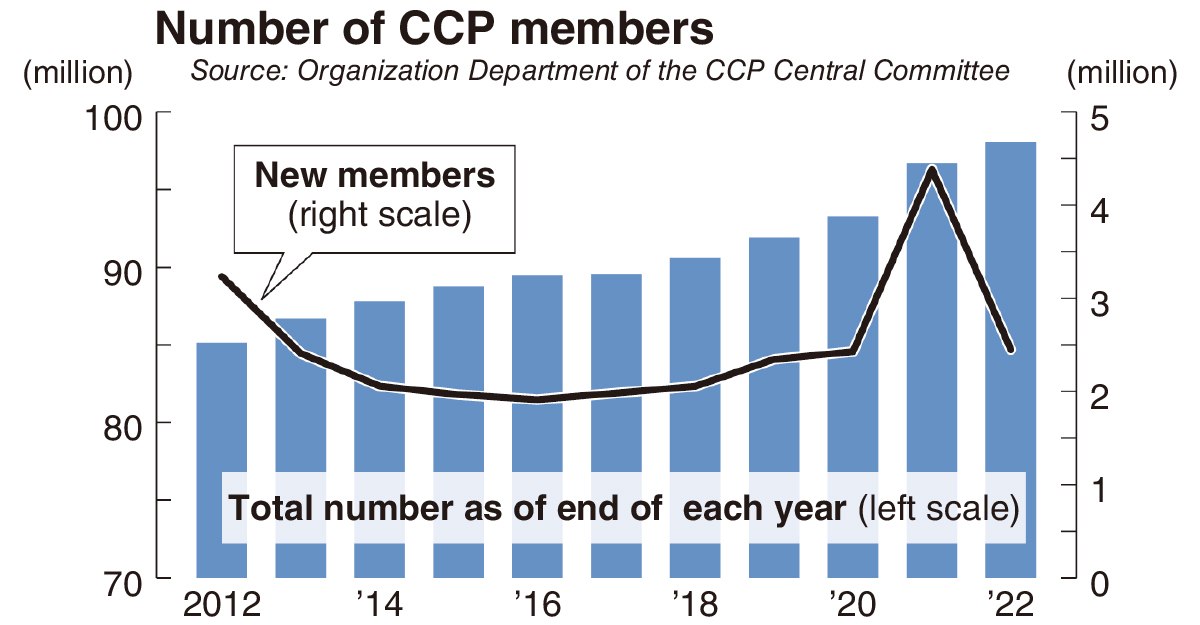
The Chinese Communist Party flag is raised during a celebration of the party’s 100th anniversary in Beijing in June 2021.
14:08 JST, July 30, 2023
BEIJING — Membership of the Chinese Communist Party is expected to hit 100 million in the near future, having increased to 98.04 million as of the end of 2022.
Though China’s population seems to be in decline, party membership is predicted to continue rising.
The CCP’s philosophy is that a limited number of elites should lead the nation. But if numbers continue to swell, this key tenet may be undermined.
Defying population decline
According to an announcement by Organization Department of the party’s Central Committee at the end of June, membership as of the end of 2022 rose by 1.32 million from a year earlier, marking a new record high.
Some 2.44 million people newly joined the party in 2022, the highest figure since the launch of Chinese President Xi Jinping’s administration in 2013 (excepting a special case in 2021, in which it recruited 4.38 million new affiliates in conjunction with the CCP’s 100th anniversary).
In 2022, some 20.96 million individuals applied to join the party, up 330,000 from the previous year. This increase may have been connected with the serious difficulties encountered by youths vis-a-vis finding employment.
“Becoming a party member is beneficial for getting promoted or finding a job as a public servant or at a state-owned company,” said a northeast region-based party member.

The composition of the CCP has been changing, too. Among newly registered members, the rising number of engineers has been conspicuous. The Xi administration has adopted slogans that stress independence and the buildup of the country’s science and technology capabilities, with an eye on a potential confrontation with the United States.
As of the end of 2022, China’s population stood at 1.412 billion, registering its first decline since 1961. Though logic might dictate that this would result in a decrease in party membership, the figure has instead been rising.
Young people key
In his first term, Xi established an “anti-corruption” stance and a policy to improve the quality of party membership by limiting applications. Based on this policy, the party initially restricted recruitment among students, resulting in an increasingly graying membership. By the end of 2019, 28.9% of the party was 61 or older, an about 3-percentage-point rise on the previous five years.
With the start of the Xi administration’s second term in autumn 2017, the party made an about-face and began boosting enrollment among students.
Another factor in the party’s rising membership figure is that party members are living longer. Now, the party is striving to attract as many young people as possible. In November, youths across the nations held protests criticizing the government’s strict measures to contain the novel coronavirus pandemic. Xi’s administration is said to believe these protests were fanned by Western countries.
Next-generation support is vital for the organization if it is to maintain its one-party rule.
“Cutting the number of newly registered young members is the only way to reduce membership,” said Daito Bunka University Institute of Oriental Studies Prof. Takashi Suzuki. “But doing so will make younger people turn their backs on the Communist Party. The Xi administration fears youth rebellion, and likely views the risk associated with rejecting young people’s membership as being larger than the risk of countering the party’s philosophy, in which it sees itself as a vanguard force.”
"Politics" POPULAR ARTICLE
-

Japan to Support Central Asian Logistics Route That Bypasses Russia, Plan to Be Part of Upcoming Summit in Tokyo
-

Japan to Tighten Screening of Foreigners’ Residential Status by Providing Information of Nonpayment of Taxes
-

Chinese, Russian Bombers Flew Unusual Path by Heading Toward Tokyo; Move Likely Meant to Intimidate Japan
-

Japan Plans National Database to Track Foreign Ownership of Real Estate, Land as It Weighs New Rules
-

Up to 199,000 Deaths Estimated From Mega-Tsunami; Most Recent Occurrence Took Place in 17th Century
JN ACCESS RANKING
-

Tokyo Economic Security Forum to Hold Inaugural Meeting Amid Tense Global Environment
-

Keidanren Chairman Yoshinobu Tsutsui Visits Kashiwazaki-Kariwa Nuclear Power Plant; Inspects New Emergency Safety System
-

Imports of Rare Earths from China Facing Delays, May Be Caused by Deterioration of Japan-China Relations
-

University of Tokyo Professor Discusses Japanese Economic Security in Interview Ahead of Forum
-

Japan Pulls out of Vietnam Nuclear Project, Complicating Hanoi’s Power Plans























